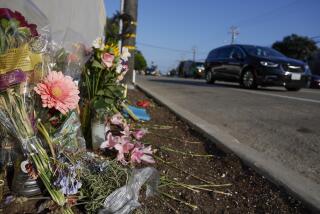Teenage Volunteers Combat Sobering Statistics
CANYON COUNTRY â Itâs 1:46 a.m. in the Bat Cave, the secret location for Safe Rides.
After four hours of videos, soda and pizza, and trying to sample all 39 flavors from a jar of jelly beans, the tired teens--three boys and three girls--prepare to call it a night.
âIâm sick of jelly beans,â Kelly Twarowski, a junior at Canyon High, blurts out.
âHey, the yellow ones with red spots are good,â counters classmate Mike Meyer.
Suddenly, the phone rings. Everyone becomes quiet.
âHello, Safe Rides,â Twarowski answers.
A 17-year-old boy says heâs drunk and needs a ride home.
Colin MacNeil, a junior at Canyon High, and his girlfriend, Candice Crane, also a Canyon student, pinpoint the boyâs location on a giant Thomas Bros. map, grab a bucket that contains rubber gloves, a cellular phone, blanket and flashlight, and head to their car to make the final pickup on a Friday night that has turned into Saturday.
Santa Clarita Valley Safe Rides was launched in December 1986 after the alcohol-related deaths of six local teenagers within 16 months. Since then, it has provided more than 7,000 rides for young people who donât want to get into a car with an intoxicated driver, or donât trust themselves to drive.
It has grown to more than 80 students from Canyon, Hart, Saugus and Valencia high schools who volunteer as drivers, navigators and dispatchers.
There are Safe Rides programs scattered in cities and on college campuses around the country. One of the largest is in south Orange County. It is operated through Mission Hospital in Mission Viejo and involves more than 300 volunteers from 10 high schools.
At least 14 such programs operated in Los Angeles County in the 1980s. Liability insurance concerns, however, put most of them out of business. But the Santa Clarita program, which serves an area with one of the countyâs highest rates of driving-under-the-influence arrests, remains strong.
Authorities and other supporters dismiss criticism that Safe Rides enables minors to drink, saying that since 1988 there have been no teen deaths in the Santa Clarita Valley linked to teens driving under the influence.
âThis is the greatest thing Iâve ever seen,â said Los Angeles County Sheriffâs Deputy Mike Shapiro, who spent a recent evening observing the program. âWhen I was this age, I was out partying. I wouldnât give up my Friday, Saturday night to help other kids. This is awesome.â
*
There were 2,210 alcohol-related traffic deaths among youths between 15 and 20 in 1998, according to the National Highway Traffic Safety Administration.
Santa Clarita Safe Rides is making an impact, participants say, by offering free rides home on Friday and Saturday nights to impaired teenagers who donât want to endanger themselves or others.
âYou make a difference, especially among your friends,â MacNeil said. âItâs pretty much a given that most high school students who like to have a good time are drinking. A lot of them donât want their parents to know. Some nights you get a call or two. Others, itâs ringing off the hook. Maybe of the couple nights Iâve worked, Iâve saved a life or two.â
Insurance liability concerns forced Mothers Against Drunk Driving to drop sponsorship of the Safe Rides programs in the San Fernando Valley in the late 1980s, according to Tina Pasco, executive director of the Los Angeles chapter of MADD. The Santa Clarita chapter turned to the Boy Scouts of America for its liability insurance.
âI still believe kids need a ride even though they know the drinking age in California is 21,â Pasco said. âMADD just canât be involved.â
Enter Penny Upton of Canyon Country, whose leadership and commitment helped convince community leaders that Safe Rides is needed.
âPeople say, âArenât you just enabling them [to drink]?â We have to deal with this immediately,â said Upton, who co-founded the Santa Clarita program. âLetâs get them off the road.â
Upton said those receiving rides are promised confidentiality, with no information passed to parents, schools or law enforcement.
The Santa Clarita Sheriffâs Station ranks second to Lancasterâs in total DUI arrests made by Los Angeles County deputies. Last year, among 17 stations, Lancaster reported 693 arrests and Santa Clarita 559.
âThere are a lot of people who like to drink and drive here,â Shapiro said. âMost of the deputies at this station live in the [Santa Clarita] valley, and weâre trying to protect our family and friends. We will arrest drunk drivers.â
MacNeil, who like more than half of the Safe Rides volunteers is a campus athlete, has a 4.3 grade-point average and wants to become a doctor.
Volunteering for Safe Rides looks good on his college resume, but the motive behind MacNeilâs participation is far more personal.
His father, Donald, a former lieutenant in the Glendale Police Department, was critically injured by a drunk driver while on a surveillance assignment in 1992. A woman ran a stop sign, crashed into MacNeilâs car and was killed. Donald MacNeil injured a hip and kidney. Heâs had 12 surgeries since the accident.
âIt was a near-death experience,â said Colin MacNeil, who was 9 at the time of the accident. âWhen I look back on it, I say, âWow, I almost lost my father.â â
To have athletes, particularly football players, volunteer for Safe Rides is an encouraging sign of acceptance, Upton said. Athletes are among the most visible students on campuses, and their participation reinforces the message that teenagers should not be drinking and driving, some Safe Ride participants say.
âIâve picked up a couple of football players that Iâve known and played with,â said MacNeil, an all-league linebacker and fullback on the Canyon High varsity. âTheyâre kind of surprised to see me, but I tell them what Iâm doing and why Iâm doing it.â
Drivers and navigators are advised not to be judgmental when speaking to their passengers. No lectures are given, no opinions offered.
Each teenager who is picked up is asked a series of informational questions, none more important than the final one: âWhat would you have done if Safe Rides didnât give you a ride home?â
âThatâs when you can tell if youâve actually helped someone out and maybe even saved a life,â MacNeil said.
Itâs up to the Safe Rides volunteer to decide whether a passenger should be picked up. If there are any safety concerns, the Safe Ride drivers are told to decline.
MacNeil said most of the passengers he has dealt with have been respectful, but several weeks ago a teen stepped out of the car at a stop light, putting MacNeilâs composure to the test.
âYou know what? If you donât get back into the car, weâre going to leave you here,â he warned the teen.
âHe got back into the car,â MacNeil said. âYou have to be very patient. You have to learn how to deal with people who arenât in a good situation. You have to help people out and get them out of trouble.â
Heather Wood, a senior at Canyon High who has been a Safe Rides volunteer for three years, said she is convinced the program works.
âThere are some people who are going to drink no matter what you tell them,â she said. âThis is a way to make sure, if they do that, they can make the smart decision not to drive and not to endanger anyone else.â
*
Itâs 2:20 a.m., and MacNeil and Crane have arrived back at the office from their final pickup. They learned their 17-year-old passenger was more impaired from smoking marijuana than drinking. Although he was not driving, he was carrying a skateboard and was in no condition to ride his board down Soledad Canyon Road.
After vacuuming the carpet, dumping the empty soda cans and straightening the office furniture, the group heads home.
It has been a slow night, with only three pickups in four hours.
But no one thinks it was a wasted night.
âWe feel we can give something back to our community and make it safer,â Crane said. âPeople trust us. They put their lives in our hands.â
*
The phone number to seek a ride from Santa Clarita Valley Safe Rides is (661) 259-6330.
More to Read
Sign up for Essential California
The most important California stories and recommendations in your inbox every morning.
You may occasionally receive promotional content from the Los Angeles Times.











